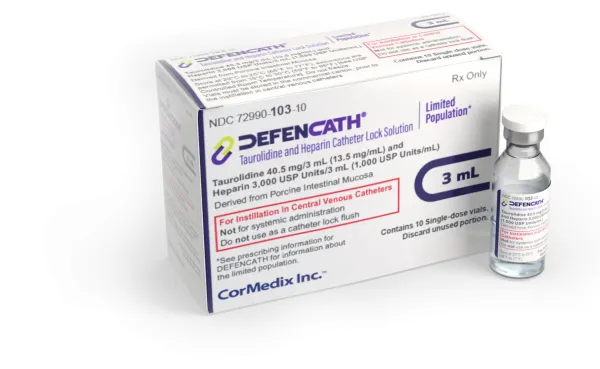Taurolidine and Heparin (Local) (Monograph)
Brand name: Defencath
Drug class: Antibacterials, Miscellaneous
Introduction
Taurolidine and heparin sodium (taurolidine/heparin) is a fixed combination preparation containing taurolidine (a thiadiazinane antimicrobial) and heparin (an anticoagulant).
Uses for Taurolidine and Heparin (Local)
Taurolidine/heparin has the following uses:
LIMITED POPULATION: Taurolidine/heparin is indicated to reduce the incidence of catheter-related bloodstream infections (CRBSI) in adult patients with kidney failure receiving chronic hemodialysis (HD) through a central venous catheter (CVC). This drug is indicated for use in a limited and specific population of patients.
The safety and effectiveness of taurolidine and heparin have not been established for use in populations other than adult patients with kidney failure receiving chronic HD through a CVC.
Taurolidine and Heparin (Local) Dosage and Administration
General
Taurolidine/heparin is available in the following dosage form(s) and strength(s):
-
Sterile catheter lock solution available in single-dose vials in the following strengths:
3 mL containing taurolidine 40.5 mg/3 mL (13.5 mg/mL) and heparin 3,000 USP Units/3 mL (1,000 USP Units/mL)
5 mL containing taurolidine 67.5 mg/5 mL (13.5 mg/mL) and heparin 5,000 USP Units/5 mL (1,000 USP Units/mL)
Dosage
It is essential that the manufacturer's labeling be consulted for more detailed information on dosage and administration of this drug. Dosage summary:
Adults
Dosage and Administration
-
Taurolidine/heparin is for instillation into CVCs only.
-
Taurolidine/heparin is not intended for systemic administration.
-
Do not use taurolidine/heparin as a catheter lock flush product.
-
Withdraw a sufficient volume of taurolidine/heparin catheter lock solution (CLS) from the vial using a sterile needle and syringe to fill the catheter lumen.
-
Use 3 mL or 5 mL single dose vial (depending on the volume of the catheter lumen) to instill taurolidine/heparin into each catheter lumen at the conclusion of each hemodialysis session.
-
Taurolidine/heparin must be aspirated from the catheter and discarded prior to the initiation of the next hemodialysis session.
-
Discard any unused portion of taurolidine/heparin remaining in the vial.
Cautions for Taurolidine and Heparin (Local)
Contraindications
-
Known heparin-induced thrombocytopenia (HIT).
-
Known hypersensitivity to taurolidine, heparin or the citrate excipient (components of taurolidine/heparin), or pork products.
Warnings/Precautions
Heparin-induced Thrombocytopenia
Heparin-induced thrombocytopenia (HIT) was reported at an incidence rate of 0.3% in Trial 1 in patients using heparin, a component of taurolidine/heparin, as a catheter lock solution (CLS). If HIT occurs, discontinue taurolidine/heparin and institute appropriate supportive measures.
Drug Hypersensitivity
Drug hypersensitivity reactions were reported at an incidence rate of 0.5% in Trial 1 in patients using heparin, a component of taurolidine/heparin as a CLS. If a hypersensitivity reaction occurs, discontinue taurolidine/heparin and institute appropriate supportive measures.
Specific Populations
Pregnancy
Taurolidine/heparin is not intended for systemic administration. It is intended for use as a CLS in patients with kidney failure requiring chronic hemodialysis; therefore, maternal use is not expected to result in fetal exposure to the drug. No animal reproduction study was conducted with taurolidine/heparin.
Lactation
Taurolidine/heparin is not intended for systemic administration. It is intended for use as a CLS in patients with kidney failure requiring chronic hemodialysis; therefore, breastfeeding is not expected to result in exposure of the infant to taurolidine/heparin.
Pediatric Use
The safety and effectiveness of taurolidine/heparin have not been established in pediatric patients. There are no available data on taurolidine/heparin use in pediatric patients.
Geriatric Use
There were 327 patients 65 years of age and older in Trial 1. Of the total number of patients using taurolidine/heparin in this study, 162 (41%) were 65 years of age and older, while 64 (16%) were 75 years of age and older. No overall differences in safety or effectiveness were observed between patients 65 years of age and older and younger adult patients.
Common Adverse Effects
The most frequently reported adverse reactions occurring in greater than or equal to 2% of patients in Trial 1 using taurolidine/heparin as a CLS were hemodialysis catheter malfunction, hemorrhage/bleeding, nausea, vomiting, dizziness, musculoskeletal chest pain, and thrombocytopenia.
Drug Interactions
Specific Drugs
It is essential that the manufacturer's labeling be consulted for more detailed information on interactions with this drug, including possible dosage adjustments. Interaction highlights:
Please see product labeling for drug interaction information.
Actions
Mechanism of Action
Heparin interacts with the naturally occurring plasma protein, antithrombin III, to induce a conformational change, which markedly enhances the serine protease activity of antithrombin III, thereby inhibiting the activated coagulation factors involved in the clotting sequence, particularly Xa and IIa. Small amounts of heparin inhibit Factor Xa, and larger amounts inhibit thrombin (Factor IIa). Heparin also prevents the formation of a stable fibrin clot by inhibiting the activation of the fibrin stabilizing factor. Heparin does not have fibrinolytic activity; therefore, it will not lyse existing clots.
Taurolidine is an antimicrobial drug.
Additional Information
AHFSfirstRelease™. For additional information until a more detailed monograph is developed and published, the manufacturer's labeling should be consulted. It is essential that the manufacturer's labeling be consulted for more detailed information on usual uses, dosage and administration, cautions, precautions, contraindications, potential drug interactions, laboratory test interferences, and acute toxicity.
Preparations
Excipients in commercially available drug preparations may have clinically important effects in some individuals; consult specific product labeling for details.
Please refer to the ASHP Drug Shortages Resource Center for information on shortages of one or more of these preparations.
|
Routes |
Dosage Forms |
Strengths |
Brand Names |
Manufacturer |
|---|---|---|---|---|
|
Local |
Solution |
40.5 mg/3 mL taurolidine and 3000 USP units/3 mL heparin sodium |
Defencath |
CorMedix |
|
67.5 mg/5 mL taurolidine and 5000 USP units/5 mL heparin sodium |
Defencath |
CorMedix |
AHFS DI Essentials™. © Copyright 2025, Selected Revisions March 10, 2024. American Society of Health-System Pharmacists, Inc., 4500 East-West Highway, Suite 900, Bethesda, Maryland 20814.
Reload page with references included
Related/similar drugs
More about heparin catheter lock solution / taurolidine catheter lock solution
- Compare alternatives
- Side effects
- Dosage information
- During pregnancy
- Drug class: miscellaneous antibiotics

